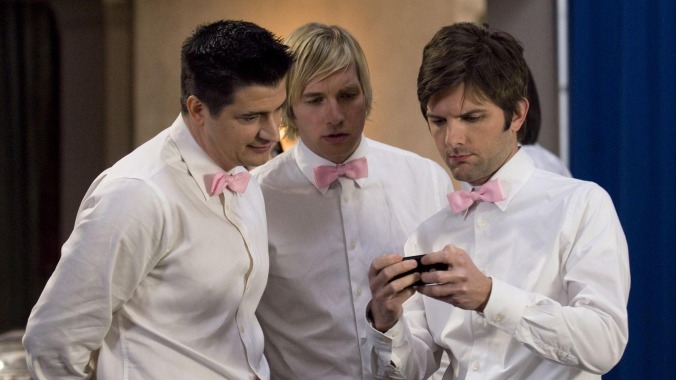How Party Down became a cult phenomenon
The Starz series turned into a sleeper success after it was canceled 13 years ago. Now, against all odds, the band is back together.

Starz’s Party Down—a scathing comedy about Hollywood wannabes working as caterers—was woefully underappreciated when it aired in 2009 and 2010. It ironically suffered a fate similar to its protagonists, who wanted to make a splash in the industry with their craft. As hard as the show’s cast and crew tried, the audience wasn’t having fun yet (to borrow a phrase used to great comedic effect on the show). Despite biting humor and critical acclaim, the two-season run ended with a pitiful 74,000 live viewers. (For context: That number matches the capacity of some of Los Angeles’ biggest venues. A series finale watch party could’ve been held at SoFi Stadium.)
The tables have fortunately turned 13 years later. Party Down’s surprising six-episode return, which kicks off February 24, has become an anticipated TV event. On the surface, it might not seem like an ideal show for a comeback, even though rumblings of a potential movie arose back in 2012. Reboots, revivals, sequels, and spin-offs are usually devoted to recapturing the glory days of old hits, as seen in Fuller House, Gilmore Girls: A Day In The Life, The Conners, That ’90s Show, and Night Court, to name a few. So does it make sense to bring back a show that wasn’t a viewer favorite, aired on a lesser-known cable network, and delivered just 20 episodes before getting canceled? Hell yeah, it does.
Party Down has become a sleeper success and it deserves a revamp now that a bigger audience is on board (hopefully way over SoFi Stadium’s limit). And luckily in the upcoming third season, co-creators John Enbom, Rob Thomas, Dan Etheridge, and Paul Rudd retain the show’s acerbic energy while updating it to reflect how Hollywood has changed in the past decade (but our heroes necessarily haven’t). To that end, it’s important to understand how Party Down evolved into a sly crowd-puller to merit this revival in the first place.
The streaming era led to a Party Down resurgence
Simply put, the show gained popularity after Hulu began streaming it in 2014, with Party Down eventually gaining a “cult classic” status (more on that in a minute). An emerging passionate fanbase, including yours truly, has mourned the Starz series’ flitting lifespan ever since. Who knows, if it had launched a bit later as streaming platforms took off, it might’ve gained more eyeballs and survived longer, akin to Netflix’s Unbreakable Kimmy Schmidt or Prime Video’s Transparent.
However, the rise of peak TV and streaming wars has already switched things up again. It’s tougher to reboot a short-lived cult show and capture the specificity that audiences fell in love with in a binge-watching vacuum. The results can be downright disappointing (Netflix’s Arrested Development reboot) or controversial (Showtime’s Twin Peaks revival, nonsense that I personally really enjoyed). Thankfully, Party Down doesn’t face that issue. Season three keeps its old-school spirit intact.
The vibes that make Party Down a cult fave
The show accurately and hilariously captured the peculiar banality of trying to make it in showbiz. It’s easy to correlate that experience to any creative field, giving Party Down a slightly broader appeal. And it provided a satirical but sharp analysis of the gig economy, a timely issue after a nationwide recession in 2008. Unfortunately, none of the deadpan wit managed to generate mainstream appeal on a platform like Starz, which hadn’t found a content sweet spot yet.
Instead, Party Down’s floundering characters discovered a niche fandom over time that could resonate with their defeatist attitude. Let me explain. As the show begins, Henry Pollard (Adam Scott) gives up on his acting goals after multiple rejections. Comedian Casey Klein (Lizzy Caplan) continually struggles for her big break. No one’s interested in Roman DeBeers’ (Martin Starr) sci-fi screenwriting. Kyle Bradway (Ryan Hansen) is an overconfident musician and aspiring star. Constance Carmell (Jane Lynch) starts off as an ex-actor. Lydia Dunfree (Megan Mullally) wishes for fame for her teen daughter. Even Ronald “Ron” Donald’s (Ken Marino)’s entrepreneurial venture keeps failing.









![HBO teases new Euphoria, Larry David, and much more in 2026 sizzle reel [Updated]](https://img.pastemagazine.com/wp-content/avuploads/2025/12/12100344/MixCollage-12-Dec-2025-09-56-AM-9137.jpg)






























